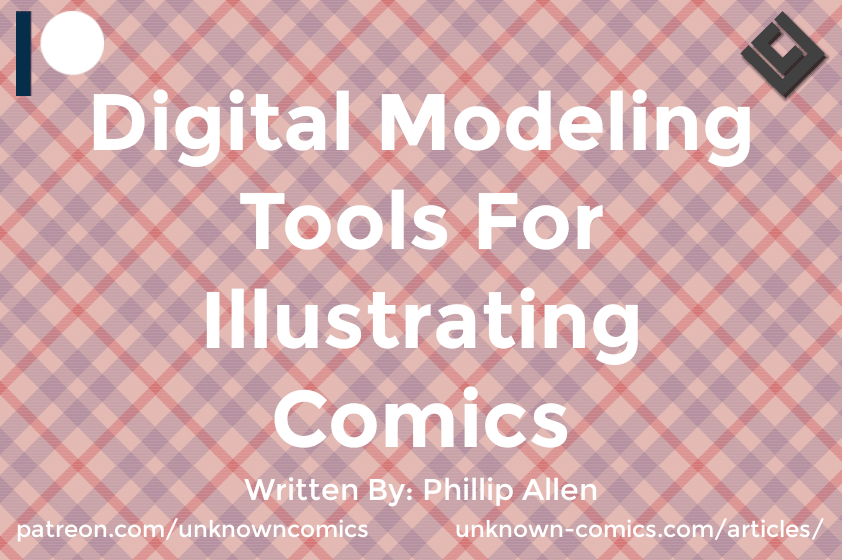Since my previous article covering some tactile modeling tools, it's only fair to consider the digital side of things as well. Digital modeling tools for illustrating comics should work to perform a similar, if not superior, modeling experience quickly so that a comic illustrator may obtain the desired perspective they are trying to draw.
And very much like the previous article, we will focus on modeling for the human form and scenery.
Digital Modeling Tools for Illustrating Comics
Before I start to discuss some of the digital modeling tools for illustrating comics, I'd like to clarify that I'll be, for the most part, dismissing the idea of using still images to model characters and scenery. Though they may be a great way to provide a quick reference when illustrating, it doesn't often provide sufficient control over the perspective in the images.
The cool thing about digital modeling tools is that the perspective can be manipulated in whichever way you'd like. You can get the image on a screen to get as close or as far away from the objects you're trying to generate models for to get it just like you'd like.
Now on to talking about the different digital modeling tools for illustrating human poses and scenery.
Digital Modeling Tools for Illustrating Human Poses
Human poses are pretty tough to illustrate, sometimes even visualize. That is why a tool like a layman exists.
Fortunately, as long as you have access to an internet connection and know where to look, digital models for the human form are available. You can find a mobile or desktop solutions to a digital layman.
So, what are the features you should consider when looking for a mobile or desktop solution for a digital layman?
Features for a Digital Layman & Available Tools
- Full control over the characters joints
- Limbs
- Fingers
- Head
- Torso
- Different types of available models
- Sexes
- Height
- Physical characteristics (i.e., muscle mass, fat, bust size, etc.)
- Option for adding additional characters into a scene
- Adjustable light source (i.e., brightness, source point, number of light sources, etc.)
- Adjustable angle of perspective with unlimited zooming capabilities
- Varied model type (i.e., traditional western comic or manga character design)
- Diverse options for props or object creation (i.e., boxes, cylinders, bikes, benches, cars, etc.)
- A cache of developer or user base generated poses for quick access to different poses and scenes.
These are all fantastic features that a comic creator may want to consider when searching for a digital modeling tool for illustrating your comic's character poses. You definitely won't need them all, unless you want absolute control over your reference materials; your experience and how these tools fit into your workflow will determine all of that.
If you're looking for examples of tools such as these, you may want to check out Magic Poser and Blender. Magic Poser is a mobile application that provides many of these features, some of the services are behind a reasonably low paywall, but there is enough available for free to get a feel for the tool and its repositories to test out. Blender is a very popular free three dimensional modeling tool that has been around for ages. It can have a steep learning curve, but there's plenty of available documentation, video tutorials, and even free models available for download if you're willing to scour the internet for them. Worst case, there are paid modeling packages that you can quickly take advantage of.
Like the article so far? Support the production of more articles like this one!
Digital Modeling Tools for Illustrating Scenery
The goals for the digital modeling tools for illustrating scenery are the same as for the tactile tools I mentioned in my previous article. We want it to relatively quickly provide a rough or detailed reference point for a comic illustrator to get a great reference point for a scene.
Fortunately, the solution for this came in the form of the very thing that inspired the 2 part series on modeling tools I've written. The answer was procedural city generators.
Features for a City Generator & Available Tools
- Control over the size of the city generated
- Control over the types of decorative or city service background components (i.e., street lamps, streets, sidewalk, etc.)
- Adjustable light source (similar to what was discussed back in the features for the digital layman)
For this particular digital modeling tool for illustrating comics, I was able to come across an add on for Blender called SceneCity. I won't go too much into it (I recommend checking out their site and doing some homework on it after this episode), but it has a ton of features that makes it an excellent choice for anyone looking to quickly, and with great detail, generate a city of varying density and building types for a reference. The only downside is that this is a paid add on. One that I plan on purchasing myself in the future, but a paid add on nonetheless.
Another tool I came across when searching for a comparable, yet free, tool was another Blender add on called Blended Cities. The results that this tool provides are of lower quality (from what I could find from my research into it for this article), but it still meets the goals of our search for procedurally generated city modeling tools.
One significant benefit of Blender is its built-in adjustable light source.
In Conclusion
We covered plenty of features you can start looking for when you're shopping around for digital modeling tools for illustrating comics, be they for human poses or different scenery with a focus on cities.
Blender can help to build out different types of sceneries outside of cities quickly, but I hope that this article will inspire you to go looking for procedurally generated scenery of various types. It sure has for me!
So, what types of digital modeling tools do you use to illustrate your comic? Have you had any experience with the tools I referenced in this article? Do you recommend other tools or features? Share in the comment section below!
Sign Up For
The Unknown Times!
Content Updates
Website News
Recommended Reading
And More to Come!
*Once every two weeks!*
Liked the article? Become part of my Patreon Community!
About The Author

Phillip Allen
Writer, Editor, and Founder of Unknown Comics
Hello there! My name is Phillip Allen and I'm the writer, editor, and founder of Unknown Comics. I am an aspiring comic book creator. In an attempt to learn how to create my own comic I came to learn just how few reliable resources existed out there. From a few books and unhelpful websites I decided to focus my attention on researching and writing a resource for both myself and the rest of the comic creating industry. This website and and its content is the result of all of that hard work.

